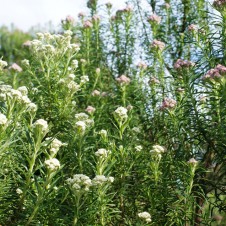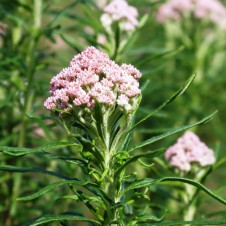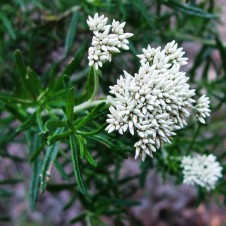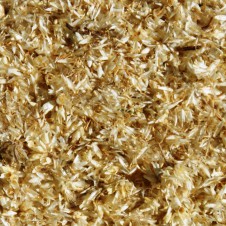General Description: Dense-crowned, medium to tall shrub 1.5-2.5 m, with dark, often hoary, narrow foliage and numerous, terminal, domed white (buds may be pink) or dusky pink flower-heads during Summer. Leaves are vaguely camphor-scented and sometimes cause skin irritation.
Flowers and Fruit: White or sometimes dusky pink, clustered into domed flower heads up to 12 cm in diameter, at tips of branches. Flowers from November to March. Fruit is minute, cylindrical seeds 0.5-1 mm long, bearing many fine, silky hairs that mean it can float in the wind.
Site Preference and Tolerances: Heavy, moist, well drained soils. This is a pioneer species in disturbed areas and is very common in forests. It is partial to dappled shade. Prefers dry gravelly soils (especially quartzose).
Life Span: Fast growth rate but short-lived (less than 20 years)
Wildlife Value: Ants and other insects eat the seeds. Wind is the main disperser of the seed. When in flower they are heavily scented, this attracts a multitude of insect species which provides food for birds and other animals. For example the longish, slender bills of brown thornbills are well suited for probing this fine foliage for largish insects and spiders. It is also a food source for other native birds including the Red-rumped Parrot, Turquoise Parrot, Yellow Rosella and Eastern Rosella. When seed collecting more insects are found mixed with this seed than almost any other species so it is necessary to leave it outside to give the insects and spiders time to escape.
Other Values and Uses: A useful pioneer plant for erosion control, recharge control and general land reclamation works. Conditions soil and provides a suitable micro-climate for the establishment of more long term species. It regenerates from seed after disturbance and establishes very well when direct seeded. It is useful for quick low-level cover in windbreaks, is easily established under eucalypts and colonises bare sites.
It is a valuable screen plant, and garden specimen plant, due to long, prolific flowering. Remove old flower heads and prune heavily to promote flowering and dense bushy shape. Foliage is used in cut flower and dried arrangements.
Other Scientific Names: Calea aculeata
Other Common Names: Dogwood, Dolly Bush, Mountain Itch, Dollybush
Germination Information: Usually grows well in a few weeks without any treatment but germination increases with light so it is good to surface sow or only cover lightly with soil.




